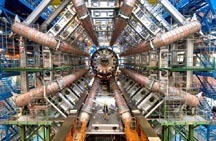
The massive Large Hadron Collider (LHC), which will smash together particles at nearly the speed of light in an effort to understand the makeup of the universe, began test operations Wednesday (Sept. 10) at the European Organization for Nuclear Research (CERN) in Switzerland, and University of Notre Dame particle physicists are key participants in what has been termed the largest experiment even conducted.
Almost 20 years in the making, the LHC is the largest and most complex machine ever made and was built, at a cost of $10 billion, to study elementary particles, the smallest known building blocks of all things. It lies 330 feet underground and has a circumference of 17 miles, straddling the French and Swiss border.
At full power, trillions of counter-rotating protons will race around the LHC accelerator ring, traveling at 99.9999991 percent of the speed of light, generating 600 million collisions every second. The most violent of these collisions will generate the heat, energy and densities that existed just a trillionth of a second after the Big Bang.
To collect data from these collisions, physicists have built huge detectors to measure the trajectories of particles resulting from the violent collisions. Although larger than an office building, they are able to measure the passage time of a particle to a few billionths of a second. The system also registers the location of particles to millionths of a meter.
Some of the mysteries of physics and cosmology that the CERN experiment hopes to solve include super symmetry, dark matter and, possibly, dark energy. A key goal of the effort is to find the Higgs boson, named after Scottish physicist Peter Higgs, who theorized the existence of such a particle that carries the force-field that gave mass to matter and made the universe possible.
Notre Dame particle physicists have long been at the forefront of the effort to gain an understanding of the fundamental constituents of matter and the forces with which they interact. They now are key participants in the CERN experiment as well. Notre Dame physicists Mitchell Wayne, Randal Ruchti, Michael Hildreth, Colin Jessop and Kevin Lannon are responsible for the development of the optical readout for the hadron calorimeter in the Compact Muon Solenoid (CMS) detector, one of two large, all-purpose detectors that will be utilized in the LHC experiments. A research faculty member, a postdoctoral fellow and three graduate students from the University were at the LHC today as test operations began.
Notre Dame particle physicists also have played a leading role in major experiments being conducted at the Fermi National Accelerator Laboratory (Fermilab) near Chicago and at the Stanford Linear Accelerator Center (SLAC) in California.
The Fermilab experiment, known as DZero, involves a search for the Higgs boson, measurement of the properties of the W and Z bosons, lifetime and particle-antiparticle mixing studies of the B meson system, and searches for new phenomena, such as super symmetry.
At SLAC, the researchers are interested in studying properties of beauty particles and in searching for CP violation of the b-system in the BaBar experiment.
The Universitys Department of Physics also has ensured that future generations of particle physicists can experience the excitement of the CERN experiment through QuarkNet, the innovative, national educational program it established for high school students. Sponsored by the National Science Foundation and Department of Energy, QuarkNets aim is to support science education in schools by establishing a nationwide science teacher education network. QuarkNet participants are contributing to the CMS detector portion at the LHC.
Contact: Mitchell Wayne, Chair, Department of Physics, 574-631-3365, mwayne@nd.edu
Originally published by at news.nd.edu on September 09, 2008.